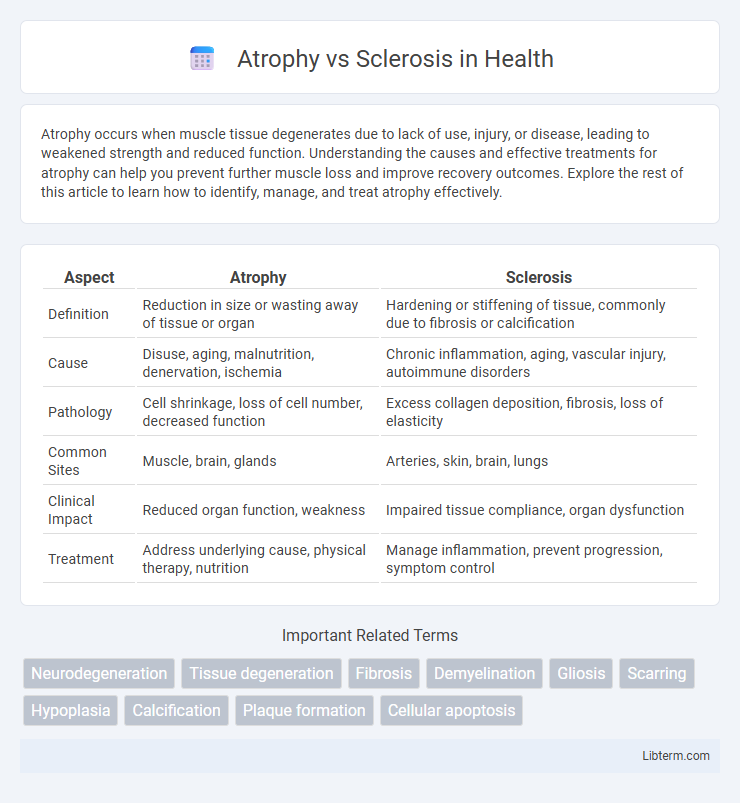Atrophy occurs when muscle tissue degenerates due to lack of use, injury, or disease, leading to weakened strength and reduced function. Understanding the causes and effective treatments for atrophy can help you prevent further muscle loss and improve recovery outcomes. Explore the rest of this article to learn how to identify, manage, and treat atrophy effectively.
Table of Comparison
| Aspect | Atrophy | Sclerosis |
|---|---|---|
| Definition | Reduction in size or wasting away of tissue or organ | Hardening or stiffening of tissue, commonly due to fibrosis or calcification |
| Cause | Disuse, aging, malnutrition, denervation, ischemia | Chronic inflammation, aging, vascular injury, autoimmune disorders |
| Pathology | Cell shrinkage, loss of cell number, decreased function | Excess collagen deposition, fibrosis, loss of elasticity |
| Common Sites | Muscle, brain, glands | Arteries, skin, brain, lungs |
| Clinical Impact | Reduced organ function, weakness | Impaired tissue compliance, organ dysfunction |
| Treatment | Address underlying cause, physical therapy, nutrition | Manage inflammation, prevent progression, symptom control |
Introduction to Atrophy and Sclerosis
Atrophy refers to the reduction in size or wasting away of an organ or tissue due to cell degeneration or decreased cell size, commonly caused by aging, malnutrition, or disuse. Sclerosis involves the abnormal hardening and thickening of tissue, often resulting from excessive collagen accumulation or fibrosis, as seen in conditions like multiple sclerosis or systemic sclerosis. Both atrophy and sclerosis signify pathological changes in tissue structure but differ fundamentally in their underlying cellular processes and clinical implications.
Defining Atrophy: Causes and Manifestations
Atrophy refers to the reduction in size or wasting away of tissues or organs due to decreased cell size or number, commonly caused by factors such as malnutrition, aging, ischemia, or disuse. It manifests through symptoms like muscle weakness, diminished organ function, and visible shrinkage of affected areas. Understanding the underlying causes helps differentiate atrophy from sclerosis, which involves hardening rather than tissue loss.
Understanding Sclerosis: Types and Triggers
Sclerosis refers to the abnormal hardening of body tissues, most commonly affecting the skin, arteries, or nervous system, with multiple types including multiple sclerosis, systemic sclerosis, and arteriosclerosis. Triggers for sclerosis vary by type but often involve immune system dysfunction, chronic inflammation, genetic predisposition, and environmental factors such as infections or toxins. Early recognition of specific sclerosis forms and their triggers is crucial for targeted treatment and disease management.
Key Differences Between Atrophy and Sclerosis
Atrophy involves the reduction in size and function of tissues or organs due to cell shrinkage or loss, commonly seen in muscles or the brain following disuse or aging. Sclerosis refers to the abnormal hardening or thickening of tissue, often caused by inflammation or increased collagen deposition, as observed in conditions like multiple sclerosis or systemic sclerosis. Key differences include atrophy's association with tissue wasting and functional decline, whereas sclerosis results in rigidity and impaired elasticity, affecting the tissue's structural integrity.
Cellular and Tissue Changes in Atrophy
Atrophy involves a reduction in cell size and number due to decreased protein synthesis and increased protein degradation, leading to diminished tissue mass and functionality. Cellular changes include autophagy, where damaged organelles are degraded to conserve resources, and decreased metabolic activity that compromises tissue vitality. In contrast, sclerosis primarily features excessive collagen deposition and fibrosis, resulting in hardening and loss of tissue elasticity rather than cellular shrinkage.
Pathophysiology of Sclerosis
Sclerosis involves the abnormal hardening and increased density of tissues due to excessive collagen deposition and fibrosis, disrupting normal cellular architecture and function. This pathological process results from chronic inflammation or injury, activating fibroblasts and promoting extracellular matrix accumulation. The dense, fibrotic tissue impairs blood flow and cellular communication, leading to functional deficits in the affected organs.
Common Diseases Associated with Atrophy
Atrophy commonly occurs in diseases such as Alzheimer's disease, where brain tissue shrinks due to neuron loss, and in muscular dystrophy, characterized by progressive muscle weakening and decrease in muscle mass. Another frequent cause is ischemic conditions like stroke, leading to localized brain tissue atrophy from insufficient blood supply. Atrophy also appears in chronic conditions like osteoporosis, resulting in bone tissue degradation and reduced density.
Conditions Linked to Sclerosis
Sclerosis is primarily linked to conditions such as multiple sclerosis, systemic sclerosis, and arteriosclerosis, all characterized by abnormal hardening and thickening of tissues. Multiple sclerosis involves the immune system attacking the protective myelin sheath of nerve fibers, leading to neurological impairments. Systemic sclerosis causes excessive collagen deposition in the skin and internal organs, resulting in fibrosis and tissue stiffness.
Diagnostic Approaches for Atrophy vs Sclerosis
Diagnostic approaches for atrophy primarily involve imaging techniques such as MRI and CT scans to detect tissue shrinkage and volume loss, often supported by electrophysiological studies to assess functional impairment. In contrast, diagnosing sclerosis focuses on identifying increased tissue density or hardening through MRI with specialized sequences like FLAIR or T2-weighted imaging, alongside histopathological examination when necessary to confirm fibrotic or sclerotic changes. Biomarkers and patient clinical history also assist in differentiating between degenerative atrophy and the fibrotic progression characteristic of sclerosis.
Treatment Strategies and Prognosis
Treatment strategies for atrophy primarily aim to slow progression through physical therapy, nutritional support, and addressing underlying causes such as neurodegenerative diseases. Sclerosis treatment focuses on modulating the immune response using corticosteroids, immunosuppressive drugs, or disease-modifying therapies to reduce inflammation and prevent further tissue damage. Prognosis for atrophy depends on the extent and cause, often leading to permanent loss of function, while sclerosis prognosis varies widely with early intervention potentially improving long-term outcomes and reducing disability.
Atrophy Infographic

 libterm.com
libterm.com